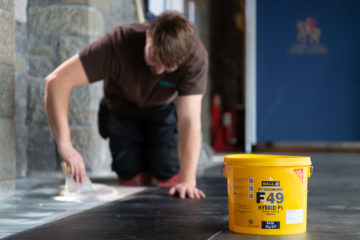Temperature tolerant adhesives have been developed for installing resilient floorcoverings in areas where temperatures have the potential to rise significantly. F. Ball’s technical service officer Chris McQuade explains when and why you need to use a temperature tolerant adhesive and provides advice on choosing the right one.
The availability of temperature tolerant adhesives raises questions about exactly when and where they need to be used. There is confusion amongst some contractors about why a temperature tolerant adhesive is required to install LVTs in conservatories, for example, but not over underfloor heating.
Why and where?
Extreme temperatures or temperature fluctuations can cause floorcoverings to expand and contract significantly. This is frequently the case in heavily glazed areas that are subject to solar gain during the day, such as conservatories, which then rapidly cool at night. Over time, this can lead to unsightly tenting and gapping at the edges of floorcoverings, particularly between adjacent vinyl tiles or planks. Once fully cured, temperature tolerant adhesives hold floorcoverings firmly in place, restricting these movements and ensuring the long-lasting performance of installations.
However, temperature fluctuations as a result of underfloor heating systems are much more gradual and less extreme than changes in temperature resulting from solar gain, which can be much more sudden and range up to +60°C. To meet British Standard guidelines of resilient and textile floor coverings, underfloor heating systems should not exceed 27°C at the bond line. Temperature tolerant adhesives are therefore only necessary where there are heavily glazed areas, including conservatories and areas with floor-to-ceiling windows.
Wet-lay adhesives
Wet-lay temperature tolerant adhesives are available for contractors who are installing vinyl floorcoverings in areas that will be exposed to high temperatures. After applying the adhesive evenly over the subfloor with a trowel, the contractor simply allows the adhesive to paste off slightly before placing the floorcoverings and then rolling to ensure overall transfer of the adhesive is achieved.
Nowadays, wet-lay temperature tolerant adhesives are available with a range of additional properties.
Styccobond F48 PLUS, for example, is a fibre-reinforced, high temperature grade adhesive for installing a range of vinyl floorcoverings.
Hybrid adhesives
The latest adhesive innovation has enabled the development of high-performance, hybrid adhesives, which combine temperature tolerance with pressure sensitive properties.
Styccobond F49 Hybrid PS is a water-based vinyl adhesive with the familiar characteristics of a pressure sensitive adhesive, which develops the extremely high bond strength and dimensional stability required to hold vinyl floorcoverings firmly in place in areas exposed to extreme temperature fluctuations (from -20°C to +60°C). The pressure sensitive characteristics of Styccobond F49 make it a great choice for installing vinyl tiles and planks.
Styccobond F49 has also been approved for installing vertical flooring accessories, such as PVC skirting, capping and coving, meaning it offers an alternative to traditional contact adhesives.
Floorcovering compatibility
Flooring contractors should always check that an adhesive is suitable for use with a particular floorcovering. For these purposes F. Ball produces its industry-leading Recommended Adhesives Guide (RAG®). Alternatively, F. Ball’s technical service department are on hand Monday to Friday, 8.30am – 5.00pm, to answer your questions about F. Ball products and how to use them.
